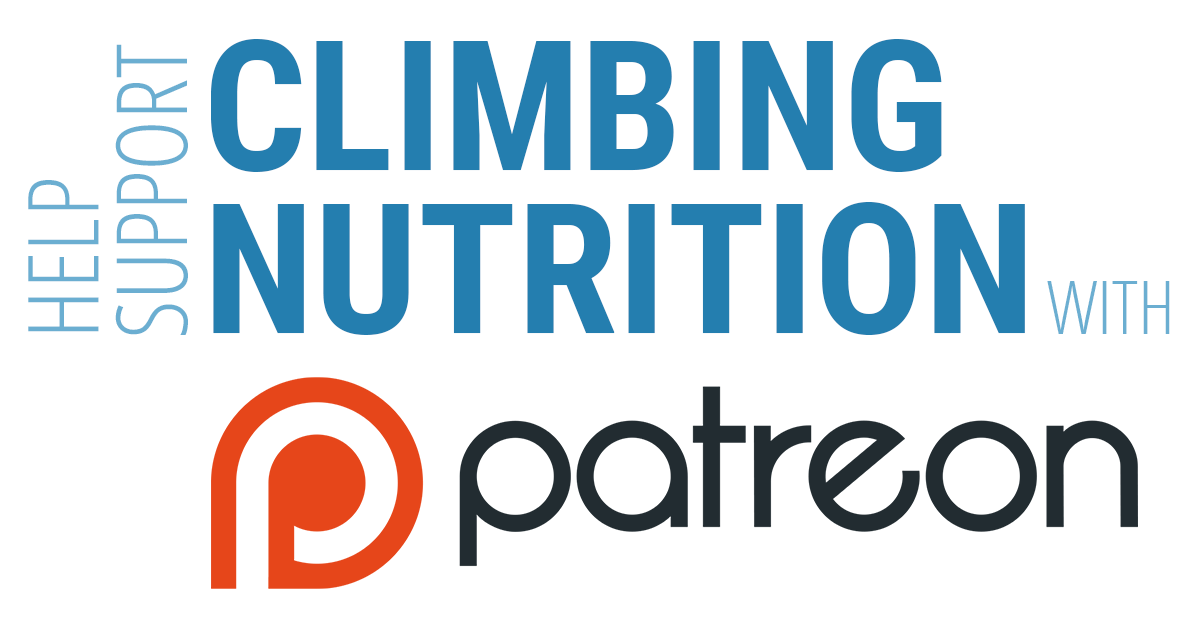Time for more Reader Questions!
In this installment, I answer questions regarding:
- The Role of Carbohydrates During Climbing (Energy Systems)
- Big Picture Protein Intake
- Creatine Cessation and Strength/Power
Question #1: The Role of Carbohydrates During Climbing (Energy Systems)
I recently come across one of your articles about the effects of anxiety on climbing performance and noticed the following statement: “A 2007 study in the European Journal of Applied Physiology revealed that elite climbers derived 8.5% of their energy from carbohydrates on easy routes. As routes grew in difficulty, this number peaked at roughly 14%. On the other hand, for less-experienced climbers on easy routes, carbohydrate reliance began at 16.5%, almost double the rate for elite climbers.” If only 8-16% was derived from carbohydrates, what fueled the rest of their efforts? I thought carbohydrates made up a much bigger chunk of our immediate energy source during climbing since ATP/CP systems are very limited and fat isn’t as efficient as carbohydrates.
-submitted by Jakub
Energy systems are really quite fascinating. We have three main systems (or 3.5, as I usually say): the phosphocreatine system, the anaerobic glycolytic system, and the aerobic system (which can be broken down into both aerobic fat burning and aerobic glycolysis, hence the “3.5”). Which system we use depends on the duration and intensity of the activity as well as our diet.
The study Jakub is referring to is this one that gave us our first (and so far only) look at what systems actually power climbing. It found that approximately 8-16% of the energy used comes from anaerobic glycolysis, with more energy coming from that system as climb difficulty increases. The rest of the energy comes from the aerobic system and the phosphocreatine system in near equal measure, particularly for harder climbs.
A cursory glance at this article would seem to indicate that carbohydrates aren’t particularly important to climbing, but it’s important to keep two things in mind:
- The aerobic system is not likely to be a direct source of power on the wall, but rather a reservoir of energy from which the phosphocreatine is replenished.
- The aerobic system is powered by both fat and carbohydrates, and carbohydrates outperform fats on a per-unit-of-oxygen basis (and oxygen is limited during climbing thanks to blood flow occlusion).
The first point refers to the inability of the aerobic energy system to supply adequate power for climbing. As a rough estimate, the aerobic system powered off fats can only produce 1/8th the energy that the phosphocreatine system can per second, and the aerobic system powered off carbohydrates can only provide 1/4th. What the aerobic system can do is trickle energy back into our more powerful systems, allowing us to use them for a little longer (but not indefinitely, of course, otherwise you’d never fall!).
When we remove that indirect energy source and look only at the direct sources, carbohydrates play a much larger role—about 25% of the total energy for a given (difficult) climb. The other 75% comes from the phosphocreatine system (and presumably a small amount from the aerobic system for lower intensity aspects like leg work). 25% is significant—imagine giving up 25% of your energy for a climb!
It’s also important to remember that our aerobic energy system is powered by both fats and carbohydrates (point #2), though the research article linked to above did not separate them out. Really, we wouldn’t have learned much more even if they had because the number one factor when it comes to the source of your aerobic energy is your diet—if you eat a lot of fat, you’ll burn more fat; if you eat a lot of carbs, you’ll burn more carbs. However, carbs do have an advantage and can produce roughly twice as much ATP per minute given the same amount of oxygen (though that figure is likely to be high if you also include adaptations to a high-fat diet)—which is why you see only a small handful of the world’s best athletes across disciplines succeed with a high-fat diet while the rest consume either mixed or high-carb diets.
All in all, carbohydrates do play a larger direct role (and indirect role) than the 8-16% figure would make it appear, but it’s also important to keep in mind this was only a single study and it didn’t control for diet. Without seeing further studies, we’re limited in how far we can interpret the results. That being said, we can always expect that the greater a role carbohydrates play in the diet, the greater a role they’ll play in your climbing.
Question #2: Big Picture Protein Intake
Could you comment on the importance of protein intake on a bigger time scale, as in the difference between active/training days, rest/recuperation days, and long periods of non-activity? I’d assume it’s important to keep the 20g every 3h up on active and rest days, but am not so sure about longer periods of rest.
-submitted by Wim
Even for long-term breaks, I would still recommend keeping protein high. You will inevitably lose strength and muscle mass during any long-term break, but keeping protein intake high does a lot to mitigate at least the loss in mass, and the neural strength can be rebuilt (relatively) fast if you maintain that muscle.
If you’re exercising less, you’ll need fewer total calories throughout the day, so the overall size of your meals (or timing of them) may change, but keeping up the frequent, moderate-dose protein schedule is probably worthwhile unless you’re never going to exercise again (and also don’t care about the general health benefits of a moderate-to-high protein diet).
Question #3: Creatine Cessation and Strength/Power
Should a climber expect a period of fatigue or a decrease in explosive strength when they cease using creatine? Obviously, any muscle built is mine to keep. However, let’s say a climber wants to take creatine during an 8 week training phase, but not long-term. If the end of the training phase (and end of creatine intake) coincides with the beginning of a projecting phase or a road trip, a period of fatigue or a decrease in strength output would be very undesirable. I have read conflicting information on this ranging from “there is virtually no adjustment time at all” to “I lost 50 lbs off my bench press.”
-submitted by Ryan
Creatine takes about a month to “wash out” of our body and decrease back to physiological normal levels. During this month, intramuscular levels decrease slowly, not all at once—and a month of time is plenty of time to adapt to the ongoing loss in strength and power, so it’s unlikely any climber would notice (at least physically) an increase in fatigue or a decrease in strength/power.
That being said, what we physically perceive is only a part of the picture, and the small amount of research we have on creatine cessation (I could find a single article) suggests that the gains in strength and power related directly to the increased availability of creatine—the ergogenic benefits of creatine, that is, not the long-term gains like increased muscle mass—fade after about a week of ceasing creatine. Since the added water weight that comes with creatine also takes about a month to fall away, and since you can expect to have 75% of that extra weight one week post-cessation, it’s unlikely that there would be any benefit to ceasing creatine before a projecting phase or climbing trip.
It’s natural, as weight-conscious climbers, to want to minimize or eliminate weight wherever possible—and the extra water weight creatine begets seems so wasteful, it’s often first on the list of things to go. The ergogenic benefits (and long-term, of course) of creatine do make up for this one downside, however! Increased strength, power, and power endurance are all boons to a climber, even if it means having to haul a couple extra pounds up the wall as well. Simply put, that extra weight is outclassed by the increases in strength, and improved performance is the result.
My recommendation for climbers is to continue to use creatine even when optimal performance is the goal—because creatine isn’t just a solid training aid, it’s a potent ergogenic aid in general!
Have a Question? Send it Over!
I’m always happy to receive and answer questions, and will always get back to you personally in short order (or at least I will now that I fixed an error in the way my inbox was sorting email)—even if I don’t post an answer publicly.
If you have a question, please visit this page here to view the (very simple) guidelines and to submit the question through the contact form (not putting my email address up publicly helps me keep spam out of the inbox). I look forward to hearing from you!
One Last Thing…
A few months back, I started a Patreon campaign to help fund the ongoing improvement and expansion of this site—I have a lot of ideas I’d like to bring to life, but don’t have the time or money to implement! While there are a lot of ways to fund websites, I ultimately decided on Patreon because it gives the choice of funding to the reader (you!) without interfering with your experience (such as by using ads) or adding bias (such as through paid sponsorships).
Basically, Patreon is a way to crowdfund a website on an ongoing basis. If you care to, you choose how much you’d like to contribute on a monthly basis, and I get to financially plan for the site better into the future knowing there is a steady stream of funding. With this funding, I can devote more time to the site (by working fewer hours at my other jobs) and more resources as well, allowing me to provide new and innovative features.
Regardless of your choice, please know that Climbing Nutrition is a free resource for all and will remain that way. Part of that free resource includes the ability to speak privately with me through email, if you have a question, which results partly in these Reader Questions columns—though the number of questions I answer privately and never put out in public are vastly greater!
I hope you consider supporting Climbing Nutrition, even if only for a $1 a month. While that may seem insignificant, it’ll build rapidly into a sustainable source of funding that allows for this site to become even better. If you’re interested or just want to know more, you can visit Climbing Nutrition’s Patreon page here.
Thank you!
Brian











